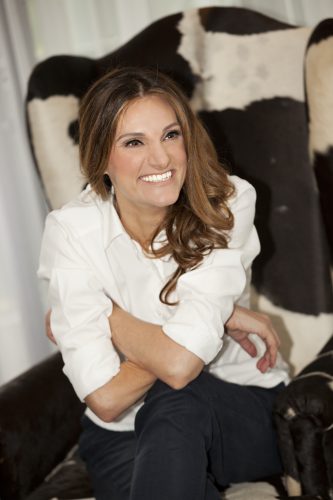Tacky monograms, fake leathers and imitation perfumes, all these once fashion faux pas are now being glorified by the internet’s nouveaux elite, who wear their fake finds like badges of honour.
B&T spoke to Vogue’s editor-in-chief, Edwina McCann and WPP’s president, Rose Herceg on how brands can untangle the mysterious rebirth of the counterfeit luxury goods industry and benefit from the intrigue in counterfeit fashion.
There was once a time when the Jenny Humphreys of the world would have been lampooned for sporting a knock-off, but it seems times have changed.
Social media has been largely responsible for young consumers’ growing interest in counterfeit luxury goods, with Gen Z and Gen Y accounting for the entire growth of the luxury market in 2022, according to a report from Bain & Co.
The report revealed that Gen Z consumers are starting to purchase luxury goods at the ripe old age of 15, three to five years earlier than when millennials did. By 2030, generations Y, Z and Alpha will become the biggest buyers of luxury goods, representing 80 per cent of global purchases.
But while Gen Z might account for the vast majority of luxury purchases by the end of the decade, that doesn’t mean the majority of Zoomers will be in the market for the goods. Price is still prohibitive — leading to an explosion in counterfeit goods purchases.
A simple search for “dupes”, Gen Z’s euphemistic term for counterfeits, on TikTok reveals tens of thousands of content creators flaunting their faux finds. From Chanel bags to Dior lip oils, TikTokers explain how they are able to get creative and save money by jumping on the dupe bandwagon.
@xoxoalyssssa The amount of times we’ve watched the original video is unreal #dupe ♬ Rumble – Skrillex & Fred again.. & Flowdan
@daus_mendoza Is this even legal ? #dupe #diorlipoil #lipgloss #beautyhacks ♬ original sound – Daus Mendoza
However, not everyone is impressed by Gen Z’s desire for designer dupes.
“What I don’t appreciate is people choosing to buy faux and somehow think that’s clever,” said McCann.
“If it is fake, the chances are it’s been made in factories that are reasonably underground, and therefore the labour and work circumstances are going to be less than acceptable”.

Edwina McCann, editor in chief & editorial director, Vogue
And that is most certainly the case with many of these manufacturers. In the documentary Fake! Inside the Terrifying, Trillion-Dollar Bootleg Industry, Ariele Elia, a curator at the Fashion Institute of Technology’s Museum in New York, explained how children were handcuffed to sewing machines in one of these factories. A lot of these workers earn less than a dollar a day and work up to 100 hours a week.
However, the problems with the counterfeit goods industry go beyond poor working conditions. According to Bruce Foucart, director of the US Homeland Security’s National Intellectual Property Coordination Center, the sale of counterfeit goods funded the terrorists responsible for the Charlie Hebdo attacks in France in early 2015. The group had been selling counterfeit luxury goods on the streets of Paris in order to gather funds to buy the weapons used in the attack.
The goods themselves can be physically harmful to the consumer as well. Cobalt-60, a radioactive isotope, is often found in metal straps and the chemicals used in the products can cause rashes and allergic reactions.
“It is undermining the IP of the designers who created these goods,” said McCann
“If people assume that it’s the real thing, and it falls apart, they may be led to believe that the quality isn’t what it actually is.
“I think all Australians are well aware of the use of the word champagne and how strict the French have been about that. If you want to protect the inherent value of things, you have to take action against counterfeits, label things for what they are and deal honestly with the consumer”.
“I think there has been a rather lax attitude to IP laws in general in Australia.
“This isn’t just a luxury goods problem, Australian and local fashion designers have also been regularly ripped off in terms of their own designs.
“When I set up the Australian Fashion Council, it was one of the issues that we raised in Canberra, the proliferation of fake Australian fashion, and how damaging that was to our designers.
“The problem with the IP laws is, that you only have to change one tiny little thing and an item becomes exempt from those laws. And by the time you are prosecuted, it’s very difficult and our designers aren’t protected overseas. It’s very expensive to register all over the world”.
According to the Harvard Business Review, the total trade in counterfeit luxury goods is estimated at US$3 trillion (AU$4.7 trillion). In McCann’s mind, these profits could have been going to the craftsmen and artisans who are trained in centuries-old crafts and possess invaluable knowledge and skills.
For example, every Hermes bag carries the initials of the artisan who handcrafts it, France maintains an apprenticeship industry where people are still trained as artisans and Chanel has kept alive the craft of couture.
“It is about appreciating fashion as an art form,” said McCann.
“I fully appreciate that the price tags are not going to be to everybody’s liking. But, I do think that there is a slight lack of understanding of what goes into making those very fine, handmade goods”.
But it seems that despite the hefty cost of the industry, brands can benefit from the interest in counterfeit goods.
Herceg added: “The reason why there are so many counterfeits demonstrates a deep desire for the brand. It’s a strange homage to a brand. Illegal, yes, but even so, they represent a desperate desire to be part of the club.
“Brands, especially luxury ones, are a shorthand for having arrived. More importantly, being in the know – and knowing what shows great taste. It feels good to have that brand, even if it’s a dupe because it acts as a psychic wink to the world”.

Rose Herceg, president, WPP
Herceg believes that there is a way to turn the love for dupes into an advantage. She recommends that brands try to bring dupe fans into their world and offer them a chance to be on the inside.
“A dupe will never be the real thing so until there comes a time when technology can track a dupe, countering the dupe must be done psychologically”, she continued.
“The global entertainment industry did a decent job of calling out piracy as a moral issue. Stealing IP is not cool. An all-out legal war is one approach. As a strategist, I’d argue that Michael Corleone was right. Friends close. Enemies closer. Which means bringing dupe fans inside the tent.
“At WPP we build desire. The stronger the brand, the stronger the desire. If anything, in a world of counterfeits, the work we do in building strong brands has never been more important”.
Herceg said that at the end of the day, she looked at the mathematics to tell this story. “Despite all the counterfeits floating around, many of these brands are experiencing record sales. There’s no shortage of customers who only want the real thing”.
Dr Marian Makkar, a senior lecturer in marketing at RMIT University added that it was “no surprise” that counterfeit goods became popular on TikTok.
“A lot of young consumers found an affordable avenue to look like their idols,” she explained.
“Technology has improved tremendously, allowing for superfakes to look and feel like the real thing while selling it for a cheaper price. Some ways for young consumers to experience luxury fashion while avoiding the harmful effects of the superfake culture could be through purchasing entry-level luxury lines such as Bvlgari sunglasses over handbags.
“Purchasing pre-loved luxury items is another way you can experience luxury fashion at a more affordable price tag and, at the same time, you would be contributing to sustainable practices. There are many online and physical marketplaces that resell legitimate luxury items at a reduced price”.
Whether it’s possible to bring buyers into the luxury fold with secondhand items at reduced prices, only time will tell.
This post was originally published on this site be sure to check out more of their content.






